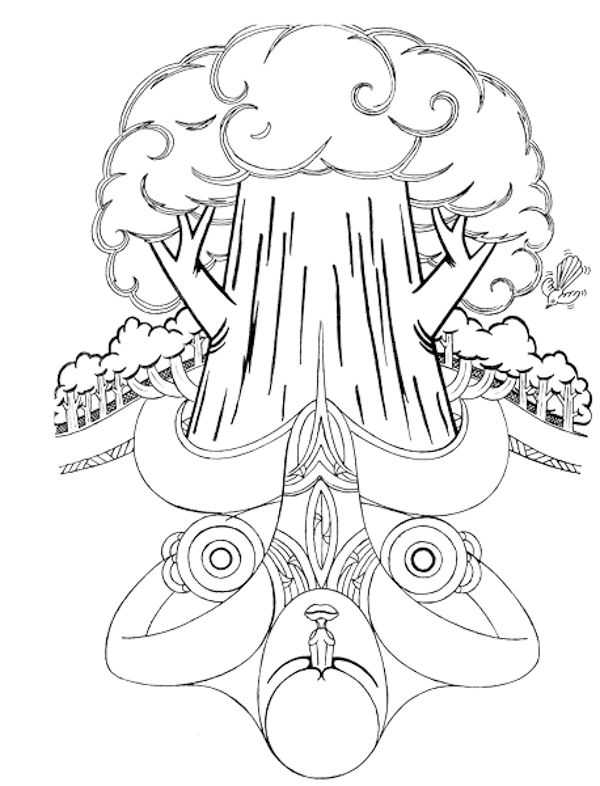
Tānemahuta, Atua of the forest and all that dwell in it. Qualities of growth, strength, shelter, diversity of life.
A holistic learning approach that is directly connected with the local environment and helps foster action competence is underway at Menzies College, a year 7 -13 school in Southland. We are lucky in that our location gives us access to three rivers and a reserve, which are mostly within walking distance of the school.
In the senior school (year 11-13) activities are targeted at standards that will allow students to attain NCEA credits in a variety of areas (Biology, Agriculture, Sustainability, Media) with opportunities to investigate and get involved with projects for much of the year. In the junior school, we offer students a taster course in stream studies, reclamation and pest control, with a view to exposing them to what we are doing in the senior school.
Pest Control and Monitoring
Year 10 students are involved in a range of projects around sustainability and this involves trapping possums at different localities and using ‘Good Nature’ traps to control rats in the Wyndham Reserve. Some students are involved in the propagation of native trees and others are monitoring the water quality and fish life of the Mimihau river as their projects.
Results of a tracking tunnel exercise with Yr 8’s. These were made out of cardboard and deployed in the tunnels after a session with Josh Sullivan from Environment Southland. The students identified the food prints and had a go at estimating the number of pests at each locality (done as part of the Yr 8, New Zealand unit).
The Year 11 students have continued their possum trapping in the Wyndham Reserve and are in touch with the local authorities about their progress. This has resulted in messages of support for the project from staff at the Department of Conservation (DoC) and the Southland District Council. We’ve had some snags with this and there has been some recent interference in our trapping program, with traps being stolen or tampered with.
There have been some discussions around what to do about this which is all part of their reflective learning process. Environment Southland are going to be removing some of the trees in our trapping area as part of a flood bank stabilisation program, so our trapping will have to be put on hold, until that is completed.
The information that has been collected is being written up for a Level 2 Sustainability internal, due towards the middle of term 4 and which could also be carried over to next year, should that be desired.
Monitoring Giant Kōkopu
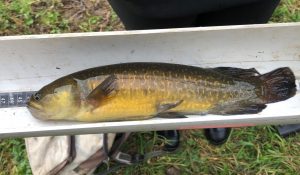
Data collection of giant kōkopu includes measurement and a photograph of the individual body pattern which is unique to each fish. This allows us to monitor growth (or not) of individual fish in our study area.
Some of the year 11 students are studying the large native fish, giant kōkopu, Galaxias argenteus, in the local reserve and this is a continuation of the project from last year. The first fish was caught in the oxbow in the middle of 2017 and we have been monitoring the population in the oxbow since late 2018. It involves setting fyke nets every week. There are no studies on giant kōkopu in lake like habitats and this has presented us with a unique opportunity to make a real difference to the knowledge of this critically endangered species.
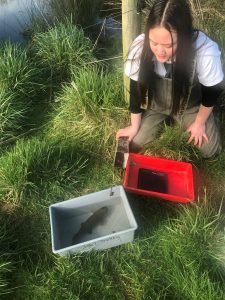
Yr 11 Science student about to process a giant kōkopu as part of gathering data for a Yr 12 sustainability standard.
We are hoping to make an estimate of the total population of giant kōkopu in the oxbow and to locate where they are spawning. There are only two known spawning sites for this species in New Zealand, neither of these in the South Island. However the student monitoring indicates spawning is occurring, as we recorded significant weight losses of some of the fish caught during spawning time. We also have evidence of milt production from some of the males caught. It also seems that there is a movement of fish into a nearby creek during spawning time and we will be concentrating our efforts on this creek when we look for newly hatched fish. We had a bumper catch of 7 different individual fish in one net and most of these appeared to have spawned, so we believe we are looking in the right place. We have been able to sex some of the fish we’ve caught and there are plans to try and fertilise some eggs artificially next year, based on the apparent ease with which eggs and milt could be harvested from some of the fish we caught.

Student checking a net for the first time. Involvement in the project gave him the confidence to have a go at the wading, when initially he was not comfortable in doing it.
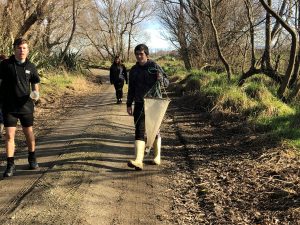
Students after monitoring of phytoplankton and zooplankton in the creek where the giant kōkopu live. Plankton forms a vital part to the diet of juvenile fish and the data that have been gathered provide information on its availability and abundance.
We were concerned that the big flood in February may have washed some of the resident fish away but have managed to catch some of them after the flood, so some have remained, which is promising. Data from this project is in the process of being written up for a Level 2 Sustainability internal.
The restoration project on the piece of land between the creek and the flood bank on a local farm is gaining momentum. The area to be planted has been sprayed with a herbicide by Environment Southland and the broom and gorse that was growing in the area has been mostly cleared, much of it by the students. We have applied for consent to get the planting underway and have identified and sourced the types of plants that we can put in, that fit within the new flood bank management plan. There are a couple of willows and large gorse plants which we will also clear. We plan to use a herbicide to kill the pest plants that might regenerate but hope to spend our time from now on planting endemics and making sure they have the best chance to get established. Planting is scheduled to take place towards the end of term 3, 2020.
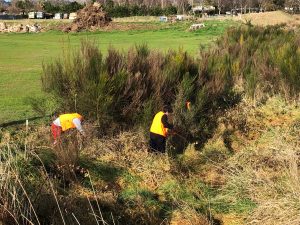
Students in the Science investigation class actively involved in clearing exotic broom from an area which has been identified for a restoration planting exercise.
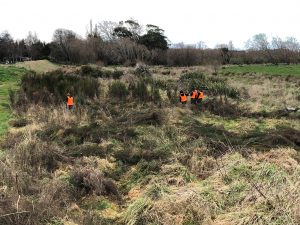
Students manually clearing exotic broom in the area identified for restorative planting. This activity can be used to obtain credits in sustainability at level 2.
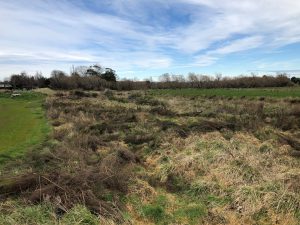
Most of the broom now removed – progress!

Year 7 students, involved in the restorative planting as part of their plants unit, planted 3 different endemic plant species each, in an hour.
Chainsaw Skills
Twelve Year 11 students attended a chainsaw course and it is hoped that they will be able to use their new skills to assist in the clearance of this area prior to the planting by cutting down the plants that our hedge trimmers cannot deal with.
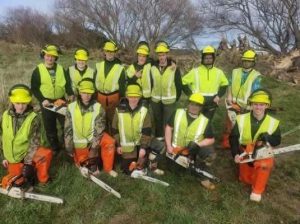
Twelve Year 11 chainsaw course
As part of a regional flood bank upgrade, Environment Southland is going to be felling some trees on the flood bank close to the oxbow lake and these could be donated to the school. We are hoping to find a place to store these trees so that the students who have completed the chainsaw course can cut them up. The wood can then be sold as a fundraiser for projects at the school.
Students have identified some age care facilities which would benefit from cheap or donated firewood during winter and this is some of the motivation to cut the wood up. The other aspect is that firewood could be used as a fundraiser for school-based projects (like buying the plants for the regenerative planting). These activities could also form the basis for NCEA credits in business studies.
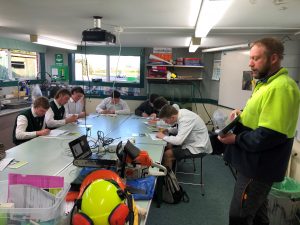
Students attending a practical and theory component of a chainsaw course from an external provider.
Benefits of the chainsaw course is that the skills are valuable for vocational purposes and lifestyle block and property maintenance. Being able to use a chainsaw safely and have some certification to this effect also provides avenues for part-time employment in our environment.
We are also working on getting a recycling initiative going at the school and are in touch with Environment Southland and the Southland District Council. We are hopeful that this can be underway sooner rather than later as it has been held up by the nationwide Covid 19 lockdown. Developments outside our control and impacting recycling on a national level were outlined to us in a recent meeting with the manager of recycling from the Invercargill City Council. This has caused a bit of a re-think on how best to move forward with our school recycling initiative.
Communication and Partnerships
As a matter of course, we maintain weekly contact with all stakeholders in the district via email. Feedback from local authorities and councils has been very positive across all fronts. We have received positive comments and encouragement from the Southland District Council and DoC about our possum trapping efforts. Environment Southland has been very proactive and involved in our activities around the clearing of weeds, the chainsaw course and the use of trees that they have cleared in our area of interest. They provide inputs and feedback on our activities and are assisting in sourcing the plants that we hope to plant and includes support from the Enviroschools Southland team. The plants were donated to the project by the Hokonui Rūnanga, the local council of Ngai Tahu.
Fish & Game have also been very encouraging about our fish and stream monitoring programmes. The local farmers have been interested in our projects and have helped with equipment and access to their properties. The Wyndham community board is well informed about our activities and have given permission for our activities on land under their responsibility. The national Enviroschools team and Toimata Foundation, who have contributed funding for this project, receive updates of the learning and work being carried out. We would also like to acknowledge the support we received from the O-I Pacific Environment Fund.
Empowerment

Student checking a net for the first time. Involvement in the project gave him the confidence to have a go at the wading, when initially he was not comfortable in doing it.
The most significant impact of what we are doing has been on the students themselves. They are out there and making a contribution to the sustainability of the environment where they live. They have experienced the success and failures of some of our activities and have learned that making mistakes is OK, provided they are not repeated and have enjoyed the hands-on method to our activities. They also understand the processes better and have learned new things about some of the unique species that live on their doorsteps. They all eat whitebait but did not appreciate that these could be the babies of the giant kōkopu in the local oxbow, until now.
“The work of the students has identified an area with a significant population of giant kōkopu on a regional and probably national level. Their efforts have raised the conservation status of the local oxbow lake, and we would have been none the wiser about them, if they had not got involved.” – A comment made by a senior scientist from Environment Southland
Banner image: Students checking nets in the local oxbow for giant kōkopu.
